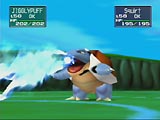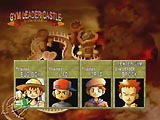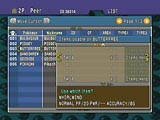I am a proud owner of all three legendary bird Pokémon. I've got both Mew and Mewtwo. I picked Kabuto over Omastar and evolved my Eevee into a Jolteon. Oh, and I just found out that my Pikachu is orange. I've played through Pokémon Yellow, Blue and Gold and I'm halfway through Silver. I'm not sure what evil powers make me play these fairly simplistic RPGs, but I know what I don't play them for: storyline, sound and graphics. That leads to only one possible conclusion. It's all about the fun of collection, character upgrades -- and, most importantly, battles.
With that in mind, Nintendo's second-party developer HAL Laboratories has devised an ingenious add-on pack to the Pokémon Game Boy games. Only that unlike the traditional add-on packs that are released on PC all year long, this one actually bridges the gap between two platforms with the help of a new accessory -- the Transfer Pak. The basic idea is to plug your Pokémon Blue, Red or Pokémon Yellow for Game Boy into the Transfer Pak and use the Pokémon you have captured in fully 3D Pokémon Stadium turn-based monster battles.
No, Pokémon Stadium is not a standalone product. If you don't own Pokémon for the Game Boy, it just doesn't make sense to invest the $60 bucks to play a game that shows its best features only when a Game Boy cartridge is plugged into your N64.
Gameplay
I've already covered a lot of this game's features in an eight-part special called Pokémon Times, so here's a very quick rundown on some of the treats that slumber inside this ingenious little game:
- In the game's Stadium Mode, one player competes in 80 different battles, divided into four tournaments. Beat the Stadium Mode and you're in for a bonus battle against the ultimate Pokémon warrior, Mewtwo, as well as a secret mode that gives you 80 brand-new, and devilishly tough battles. There is virtually no way you can beat the secret mode without having trained your own, elite Pokémon.
- One to four players compete against each other or the computer in a no-holds-barred battle with customizable rules. You can select rental Pokémon for these battles -- but that makes them much too predictable since their selection of techniques isn't determined by the trainer. You can also select quick and easy versus and random battles.
- Battle against all the gym leaders that appeared in the Pokémon Game Boy games and win up to eight semi-rare to rare Pokémon that you can add to your Game Boy party and Pokédex!
- Get full control over your Pokémon PC Boxes and examine, sort, group and move your Pokémon. You can even bring up tables that display moves, abilities, ID numbers, area locations, and more on one screen. This lets you easily compare new Pokémon you have caught to see which ones are worth keeping.
- Organize, sort and store whole PC Boxes (which hold up to 30 Pokémon)

- on the N64 to free up room on your GB cartridge. Up to 240 Pokémon can be stored on the N64 cart. You can even give a whole box full of Pokémon to a friend.
- Store items on the N64 cartridge. You can't give them to a friend since the GB cart ID numbers have to match, but it frees up room in your GB inventory. Up to 400 items can be stored in four different ID boxes.
- Examine and compare Pokémon techniques. See what every attack's accuracy rating is and get detailed descriptions on what they do.
- An expanded Pokédex lets you look at your Pokémon in detail and bring up detailed map data that shows you where you can catch them in the GB games.

- Trade Pokémon with a friend using easy on-screen controls.
- Play Pokémon Red, Blue or Yellow on your TV screen using the GB Tower Mode. The emulation is flawless, but HAL actually went a step further. You can unlock two extra speed settings that let you play your Game Boy Pokémon at hyper speeds. This is incredibly helpful if you want to upgrade certain Pokémon and do as many battles as possible in very little time.
- Collect trophies for winning battles. Try to get one for each Pokémon to unlock a secret.
- Compete in nine Mario Party type mini-games with up to four players.

- Snap pictures of your Pokémon in the Gallery Mode and print them out as stickers in participating stores.
- See all 151 Pokémon and all attacks and defense moves in glorious 3D.
As you can tell from the list of features, Pokémon Stadium is packed full with goodies that should make Pokémon Game Boy owners salivate. No, it's not an RPG -- and as such, it doesn't have a storyline or a quest mode. Pokémon Stadium is a clever add-on package that's based on the Game Boy games' popular Colosseum battle mode and not only enhances the GB games, but actually got me to go back and invest even more time into Pokémon Yellow. Sure, the initial attraction is to see your Pokémon in 3D, and Stadium definitely delivers the goods when it comes to bringing the creatures to live. But the battles quickly become meaningless if the combatants you're using aren't really yours.
 Although the Pokémon Stadium mode is considered to be the main attraction, the Gym Leader Castle is probably the feature GB Pokémon owners will like best. Every time you beat it, you are randomly awarded one of eight Pokémon. For many gamers who don't have the chance to trade with friends, this is virtually the only way to get a complete Pokédex. I've got myself four new Eevees, two of which I evolved into Flareon and Vaporeon (since I initially only had a Jolteon). I won Omanyte and went back into Pokémon Yellow and had it evolve to Omastar. Pokémon Blue and Red owners can also finally get the other two starting Pokémon (out of Bulbasaur, Squirtle and Charmander). But the upgrades you get in the Stadium mode are equally impressive. Playing the Game Boy games in four-times the speed on your TV screen is awesome. No longer do you have to wait 20 seconds to heal your Pokémon at a Poké Center. Just kick the thing into overdrive and you're done.
Although the Pokémon Stadium mode is considered to be the main attraction, the Gym Leader Castle is probably the feature GB Pokémon owners will like best. Every time you beat it, you are randomly awarded one of eight Pokémon. For many gamers who don't have the chance to trade with friends, this is virtually the only way to get a complete Pokédex. I've got myself four new Eevees, two of which I evolved into Flareon and Vaporeon (since I initially only had a Jolteon). I won Omanyte and went back into Pokémon Yellow and had it evolve to Omastar. Pokémon Blue and Red owners can also finally get the other two starting Pokémon (out of Bulbasaur, Squirtle and Charmander). But the upgrades you get in the Stadium mode are equally impressive. Playing the Game Boy games in four-times the speed on your TV screen is awesome. No longer do you have to wait 20 seconds to heal your Pokémon at a Poké Center. Just kick the thing into overdrive and you're done.
The battles themselves are only as exciting as your Pokémon. If you've got a crew of level 100 mega-monsters, you'll definitely see the sparks fly. But even if you've spent weeks upgrading your favorite six, you can't just blaze through the game without losing some of the duels. Nintendo was smart enough to put a few rules and regulations in some of the tournaments that force you to use Pokémon of a certain size or level. That way, you won't just use Mewtwo, Zapdos and co. over and over again, making for more varied battles.
The computer's AI starts off really easy. You won't have a problem beating the first few tournaments, even if you're using the so-called "rental Pokémon" that are available to fill gaps in your Pokémon lineup (or for those courageous players who say they don't need the GB games to fully enjoy this game). But wait till you get to the higher tournaments and you will see the difference to the GB games' AI! The computer will employ different tactics, such as trying to take your best Pokémon out first with self-destruct moves. It will withdraw Pokémon that are susceptible to your Pokémon type's attacks. It will use Thunder Wave to slow your fastest Pokémon down. It will poison you with Toxic and try to stall you by putting you to sleep or using Fly and Dig. It will drive you insane with Wrap.
But just like RPG battles in games like Final Fantasy, the battles in Stadium can get old after a while. That's where the multiplayer tournaments come in. Competing against a human player who is probably trying to trick you and do things you wouldn't expect adds a whole new level to Pokémon battles. You have to actually try to analyze the situation and figure out what your opponent is likely to attempt next to be successful. Since the battles are turn-based, the fun definitely isn't on the same "I'll get you!" level as in games like Smash Bros. or Mario Kart. It's more akin to a strategy game like chess -- only that the pieces in Stadium roast each other with Fire Blasts and shoot spores out of their heads.
For those with short attention spans, there are also nine Mario Party-inspired mini-games. Some, like Clefairy Says and Ekans' Hoop Hurl make for fun little four-player battles, but most of the other games are just button mashers and won't keep your interest long.
GB Tower mode aside, the most useful mode for Pokémon GB fans is probably the Pokémon Lab mode where you can organize everything, compare Pokémon, and so forth. Once you have used the Lab, you will notice how rudimentary the menu systems in the Game Boy versions really are. Teaching your Pokémon moves from TMs and HMs is made really easy, since you can now see what each machine does and what Pokémon can learn the respective moves. These excellent additions round off what I think is one of the more original console titles to come along in a long time. It's only too bad the game sells at full price (necessitated by the inclusion of the Transfer Pak), which will make some N64 owners expect more than just an expansion of the Game Boy titles.
Graphics
All battles take place in closed-off arenas with simple backdrops inspired by the anime series. The environments are pretty unimpressive -- but that's for a reason. The polygonal Pokémon are where it's at. These soft-skinned beauties are not only highly detailed and look exactly like their TV counterparts, they also move with such convincing animation that it seems likely that Nintendo has found a way to motion-capture real-life Pokémon. The bird animations are especially impressive and each of the 151 Pokémon has a unique (and often hilarious) "fainting" animation as well. There are so many neat details, that it's impossible to list them all. Grimer and Muk drip and ooze as they try to maintain their shape, Cloyster's horns rotate, Venusaur gets bloodshot eyes when it's in trouble, Jolteon shakes its head and stumbles backwards after a hit and Lickitung is at its most disturbing. Some of the size differences that weren't apparent in the Game Boy versions are also beautifully reproduced. Just pit a Gyarados against a Magikarp and you'll understand... And best of all, the framerate is rock solid.
The attack graphics are equally impressive, with colorful particle animations and screen-shaking special effects. Like in the Game Boy games, the Pokémon never actually physically "touch" each other -- which comes as somewhat of a disappointment. Luckily, all the elemental attacks and their effects on the Pokémon are shown in their full glory, so it isn't really that big of a deal if you can't actually see two Pokémon make contact with some of the more boring moves like Slash and Stomp.
The high-res menu screens are very well laid out and can be understood and navigated quickly, without the need of a manual. Overall, the game's graphical presentation is top notch, though it naturally can't compete with adventure or platform games since it lacks environment detail.
Sound
Pokémon Stadium's most disappointing area is its sound. I was ready to be blown away by some MoSys goodness when I saw the name "Factor 5" appear on the title screen -- but it turns out that Nintendo only used the developer's patented M.O.R.T. voice compression for the game's announcer. While the announcer isn't terrible, he quickly started to annoy me with the phrase "from the word go" and some of the most general statements ever, like "There is a distinct difference in the number of remaining Pokémon!" I was almost expecting to hear things like "One Pokémon won, the other one lost," "The sky is blue!" and "There is one Pokémon fighting another one!"
To make things even worse, there are hardly any real Pokémon voices in the game. Nintendo added Pikachu's trademark noises for the US version (they weren't in the Japanese release) and you can hear some of the voices in the mini-games, but that's about it. For most of the Pokémon, you only get generic monster sounds -- not the endearing "Squoitle!" and "Ekanssssssss!" that made the characters so memorable. I realize that the animations and poly models for 151 different Pokémon take up a lot of room, but considering the fact that Capcom can release a 512 megabit game (RE2), it would have been nice to see Nintendo treat its biggest franchise with the same respect. Nintendo could have at least tried to include the sounds for the most popular Pokémon like Charmander and Meowth.
To add insult to injury, the samples used for the music are terrible, making everything sound really tinny. Sure, the melodies are instantly recognizable and sound better than the Game Boy tunes, but the audio is nowhere near the quality of some of the recent Nintendo releases. On the up-side, the battle noises are all above average.
Peripherals
Stadium supports only the Transfer Pak, which is included with the package. While you can register your Pokémon and play two-player battles with only one Transfer Pak, two are needed for traditional one-on-one Pokémon trading. For more information on the Transfer Pak, check out IGNpocket's detailed special.
Pokémon Stadium presents a great first step in linking a handheld and a gaming console for a more complete gaming experience. I think Nintendo is definitely on the right track and hope we'll see more Transfer Pak compatible titles on the N64 (as well as expanded compatibility between GBA and Dolphin) in the future.
A must-buy for Pokémon fans.